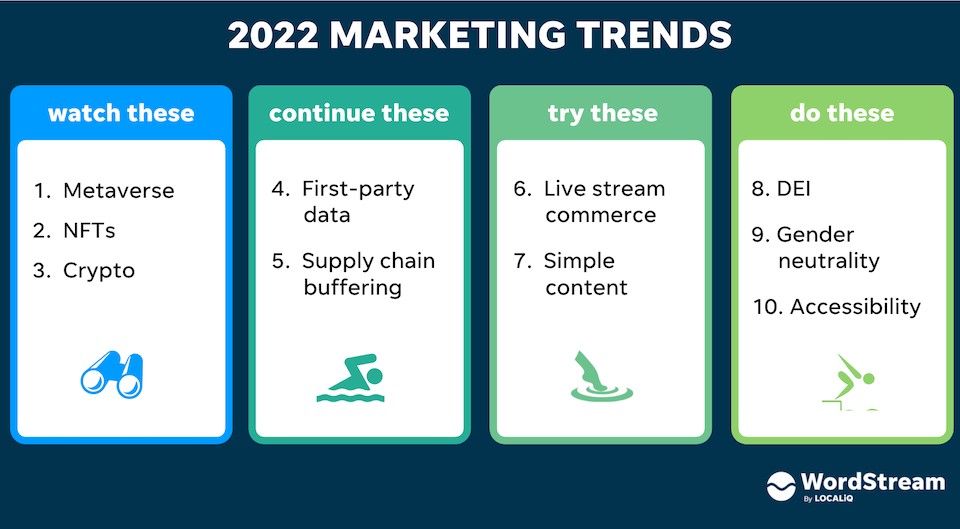
2021 Digital Marketing Trends: The New vs the Tried and True
December 1, 2021
10 Important Cryptocurrencies Other Than Bitcoin
March 1, 2022
If you’re wondering how to use social media for small business, look no further than these 12 essential tips to get started.
If you have a business, you likely spend a lot of your time trying to dig up the latest social media marketing tips. And for good reason.
There are now 4.2 billion active social media users—almost twice as many as there were just five years ago. Those users spend an average of 2 hours and 25 minutes on social channels every single day.
Those nearly 2.5 hours offer an incredible opportunity for businesses to:
- build brand awareness
- develop customer relationships
- and even make sales directly within social platforms.
Here are all the social media tips you need to market your business in 2021.
12 essential social media tips for business
1. Start with a plan
It’s easy to get started using social media for business purposes. We all use social media in our day-to-day lives, so there’s a level of comfort with the tools.
It doesn’t cost anything to create a Facebook Page for your business, or start posting on Instagram, or create a presence on Twitter.
But before you leap in feet first, remember: every good business strategy starts with a good plan. Yes, you can use social tools for free. But the time and effort involved still represent an investment in your business.
Without a plan, you have no clear goal for what you’re trying to achieve. That means there’s no way to know if you’re getting a return on that investment.
Take the time to create a social media plan upfront. This ensures all your social efforts support specific business goals.
Here are some strategic social media tips from our guide to creating a social media marketing plan:
Set social media goals and objectives
Create goals that follow the SMART framework. They should be specific, measurable, attainable, relevant, and timely.
Base your goals on metrics that will have a real impact on your business. For example, you could aim to acquire customers or raise your conversion rate, rather than simply racking up likes.
Research the competition
How are your competitors using social media? While you don’t want to copy them, learning from what others have done is a great way to reduce your learning curve.
A competitive analysis can help you learn what’s working and what’s not for other businesses like yours.
Conduct a social media audit
If you’re already using social media, now’s the time to take a step back and evaluate your existing efforts.
We’ve got an easy-to-use social media audit template to walk you through the process.
Get inspired
You’ve looked at what your competitors are doing online, but what about other businesses? Take inspiration from the success of businesses in all industries.
Where can you find these success stories? Head to the business section of most social networks’ websites and you’ll find useful case studies.
This blog can also be a great source of inspiration, since we always include lots of examples. And just pay attention to what your favorite brands are doing. What makes you want to click or follow or buy?
Create a social media calendar
A social media calendar helps you post the right content to the right social channels at the right time. It should include a plan for your content mix.
Try starting with the 80-20 rule. Use 80% of your content to inform, educate, or entertain your audience. Use the other 20% to promote your brand or sell your products.
2. Decide which platforms are right for you
Don’t make assumptions about where your audience spends their time online.
Your instinct might tell you that if you’re targeting Gen Z, you should skip Facebook and focus on Instagram and TikTok. But the data shows that nearly a quarter of Facebook users are aged 18 to 24.
Source: Digital 2021
If you’re selling to baby boomers, social might not seem like a top priority. But it should be. Facebook and Pinterest are the top social networks for boomers. Adults over age 65 are Facebook’s fastest growing audience segment.
Maybe you think TikTok marketing is not the right fit for your brand. But even well-established brands with an audience well outside Gen Z are experimenting with this platform.
Keep in mind that TikTok saw 56 million new app downloads in December 2020 alone.
We’ve compiled demographics information for all of the major social networks. Use it to help gauge where your audience spends their time online. But remember that these demographics are just an overview.
To make sure you’re using social media for business effectively, you’ll need to conduct some research of your own. This will help you to understand how your specific audience spends their time online.
Choosing your platforms doesn’t have to be an all-or-nothing approach. You can use different social channels to reach different audiences, or to meet different business goals.
The average internet user has 8.4 social media accounts, so you can connect with them on different platforms for different purposes.
For example, you could use Facebook to build your audience and generate leads, and Twitter for customer service.
3. Know your audience
One reason using social media for business is so effective is that you can micro-target your audience. But first, you need to understand who your audience is.
Start by compiling data on your current customers. Then, dig deeper with social media analytics. You’ll soon start to understand who’s buying from and interacting with you online.
Hootsuite Insights Powered by Brandwatch can help you uncover detailed information like the top hashtags, referral sites, and even specific social authors for terms relevant to your business.
Once you’ve defined your audience, you can create buyer personas, which will help you understand the best ways to speak to your audience. We’ve got a free buyer persona template to help you get started.
4. Expand your audience
Once you have a clear picture of who your audience is, you can revisit your social media plan. It’s time to look for ways to reach more people just like them.
For example, when lockdown measures meant more people were looking for ways to fill their time at home, The Great Courses Plus switched up its Facebook advertising strategy to expand its audience quickly.
They created an extended free trial offer and advertised it to a broad audience in the United States. They then used lookalike audiences to reach new audiences in Canada, the UK, and Australia who were similar to their best existing customers.
Source: Facebook
This expanded audience strategy saw a more than 10 times increase in total average monthly subscriptions generated.
You can also use social media to expand the audience for your local business. For example, Hootsuite geo-search streams can help you monitor and respond to local conversations about your business. You can then reach new potential customers who are already in your geographic area.
5. Build relationships
The unique benefit of social media marketing for small business is that it allows you to talk directly to customers and followers. You can build relationships over time, rather than asking for a sale upfront.
That said, you certainly can use social to get a sale upfront, as we explain in Tip 7.
More than 44% of internet users use social networks to research brands. Part of that discovery is getting to know who you are as a brand and what you stand for.
When people engage with your organic content or ads, it’s a great idea to engage back. This helps to build trust and form a loyal following. As fans share and like your content, you rise in the social algorithms and gain new, free, exposure.
For most Facebook users, there are more than 1,000 potential Newsfeed posts at any one time. Engagement is one of the signals Facebook uses to help predict which of those posts users are likely to see. When you establish relationships with your followers, they are more likely to see your posts.
Nurturing relationships can also help you build a loyal community that will lead to ongoing sales over time. New customer acquisition is great, but don’t downplay the value of customer retention.
In Hootsuite’s Social Transformation survey, 69% of respondents said social media helped maintain customer relationships during the very different marketing era of COVID-19. And Twitter data shows 70% of people say it’s important for bands to help boost positivity right now.
So how do you build relationships, beyond responding to follower comments on your posts? Try these strategies:
Create a Facebook Group
Facebook Groups are another great way to build community and brand loyalty.
For example, the New York Times Podcast Club Facebook Group is “a book club for podcasts.” With more than 37,000 members, the group establishes the NYT as a go-to source for information beyond breaking news.
It also motivates members to listen to the selected podcasts each week, helping to prevent listener drop-off.
Connect with other entrepreneurs and influencers in your niche
Think your business is too small to work with influencers? Micro-influencers and nano-influencers with as few as 1,000 dedicated followers can be effective for establishing brand trust.
As a bonus, they are often well within the budget range of smaller brands.
The lingerie brand Lively partnered with influencers, including those with a small targeted following, to promote their bralettes and skincare products.
Mention followers in your posts and Stories
Collecting user-generated content through contests and branded hashtags is a great way to source quality material for your social feed. UGC is also a powerful source of social proof.
Even better, sharing your followers’ content on your social channels (and tagging them, of course), helps you establish relationships with some of your biggest fans.
If a fan tags you in an Instagram Story, you’ll get a notification in your direct messages. Be sure to reshare—it’s an easy win-win.
Use the social platforms’ built-in interactive tools
From Twitter polls to interactive stickers in Instagram Stories, there are plenty of ways to spark specific interactions with your followers.
For example, Panera Bread launched a relationship-building campaign this summer to draw attention to its new coffee subscription. They announced they would give away free coffee all summer if 500,000 people voted Yes in in their Twitter poll.
“We are a brand that is built on strong 1:1 relationships with our customers,” said Kelli Nicholson, Panera Bread’s Director of Brand Marketing. She told Twitter the campaign was an important way to evaluate whether the coffee subscription program was something customers would value.
6. Pay attention to trends
We’re not saying you should leap on every meme that goes viral. (Please don’t leap on every meme that goes viral.)
But it is a good idea to pay attention to trends in social media, so you understand what people are looking for when they sign into their social channels. This helps you create appropriate content that resonates over time.
State Farm insurance has an ongoing Pinterest campaign that provides informative content tied to major life changes like buying a car or having a child. Since these moments tend to impact insurance needs, it’s an obvious fit that has helped the insurance giant connect with millennials and Gen X.
Last spring, as travel changed from a worldwide affair to a much more local experience, road trips were a hot topic of online research. State Farm created a series of Pins about road trips and how the company helped protect their customers in uncertain times.
The top five reasons people use social media now are:
- To stay up-to-date with news and current events
- To find funny or entertaining content
- To fill up spare time
- To stay in touch with friends
- To share photos or videos with others
- Always keep your audience’s current needs in mind. What worked last year might not work today.
- Social listening is a highly valuable information gathering tool, helping you understand what your audience (and potential audience) might want to hear from your brand.
- That’s one reason why two-thirds of respondents to the Hootsuite Social Media Trends surveysaid social listening increased in value in 2020.
- We’ve created a whole guide on how to use social listening for your business.
7. Sell your stuff with social commerce
Social media marketing has evolved in recent years to include social commerce: the ability to sell your products directly from social channels. And business is booming, with a global market value of $89.4 billion in 2020.
By June 2020, 18.3% of U.S. adults had made a purchase via Facebook, and another 11.1% via Instagram.
You can now use social shopping tools to sell your products and services even without a website.
We break down all the details in individual posts explaining how to use Instagram Shopping, how to sell with Facebook Shops, and the best ways to use Instagram Live Shopping.
8. Mix up your formats
Make sure to switch up your social post formats from time to time. If you usually post GIFs, try a JPG. If you normally post still images, try a video.
And take advantage of all the formats within each social network, like Stories, or Reels, or Live video.
For one thing, this helps you learn which formats work best for different types of content (more on that below) and for different social networks.
For example, the conventional wisdom is that posts with images always fare better. But Hootsuite recently ran an experiment in which plain text Tweets outperformed those with an image or GIF.
This was not true a couple of years ago, and Hootsuite would never have made this discovery if every Tweet contained an image.
Here’s another reason not to fall into a rut: The Facebook algorithm uses “content type diversity” to ensure a person’s newsfeed had a good mix of content types. Switching up your formats may boost your content’s reach.
When you do want to use images and don’t have a great photo library of your own, stock photo sites are a great source of free, high-quality photos to use in your social posts. Don’t use random images you find online. That is definitely not okay and can get you in some serious trouble.
Finally, be sure all your posts, regardless of the format, are inclusive and accessible. For a start: Add alt text to images and make sure videos have captions. And make sure your audience is fully represented in the images you share.
9. Focus on quality over quantity
The sheer number of social media marketing options for small business might seem overwhelming—but you don’t need to do it all. It’s more important to create quality content on a couple of key channels than it is to have a presence on every single network.
Above all, be sure that your social posts offer value. If all you do is pitch and sell, there’s very little motivation for people to follow you. Remember, social marketing is about building relationships.
Be human. Be honest. Post great content. This is important, and you can’t fake it.
You can’t do it all, and there’s no reason to try. Reach out to your audience in the places where they’re already spending time online.
Focus on using one or two social channels really well, at least to start. Once you’ve got those mastered, you can build from what you’ve learned and expand your efforts.
10. Use the right tools
The secret to using social media effectively is to take advantage of tools that automate or simplify much of the work.
There are loads of tools to help boost your productivity. That means you can start using social media for business without having a full-scale social media team.
Here are some of our favorites.
Engagement management
Social media is not a broadcasting system—it’s a way to engage with customers and fans.
Social media management tools like Hootsuite can help you centralize all mentions and messages directed at your company in one dashboard. Then you can respond and engage without having to log into each of your individual social media accounts.
Analytics
Getting all of your analytics data in one place can help you get a better picture of your social efforts overall.
Hootsuite Insights powered by Brandwatch provides a great overview of how well you’re capturing the conversation in your space. And Hootsuite Analytics allows you to create detailed reports of your performance across social channels.
Graphics
If you’re having trouble creating eye-catching images for your posts, turn to tools that will help get the job done.
VSCO, A Color Story, and Canva are some of our favorites. You can find more photo-editing tools in our post on how to edit Instagram photos.
Content curation
It can be a struggle to come up with new content to share every day. Content curation can help. It’s the art of sharing quality posts from others (with credit, of course).
It can be a great way to provide value for your followers and keep them engaged. Tools like BuzzSumo and Pocket can help you find and organize content to share. You can find more content curation tools in our beginner’s guide to content curation.
11. Use scheduling and automation to free up more time for engagement
We talked about creating a social content calendar way back at the beginning of this post.
Once you have that calendar in place, you can create your social posts in advance and use scheduling tools like Hootsuite to post them automatically at the right time.
This allows you to dedicate one block of time per day or even per week to creating your social content. It’s much more effective than letting social posting take you away from other tasks throughout the day.
Automation tools like chatbots can also help you cut down on the number of hours you spend working on social media marketing.
12. Track and refine your performance
As you implement your social strategy, it’s important to keep track of what works and what doesn’t. You can then fine-tune your efforts and improve results.
The analytics tools mentioned above give you a great picture of your social efforts and can help track whichever metrics matter most to you.
Once you have an idea of how your strategy is working, it’s time to start looking for ways to improve. Using A/B testing, you can make small changes that boost your success over time.
For example, the land development advertiser Newsome Interactive LLC used testing to discover that “Learn More” was the best call to action for their Facebook ads that clicked through to Messenger.
It was not that “Learn More” resulted in the most clicks. Instead, it best set people up to complete a full chat sequence and contact form so Newsome could collect qualified leads.
“Chat Now,” on the other hand, led people to ask specific questions and drop out of the chat sequence before it was complete.
No matter the size of your business, social tools can help you better connect with your audience, reach new potential customers, and increase awareness of your brand. If the possibilities seem overwhelming, just start small.
As you find what works, expand your efforts and your audience. One of the great advantages of social media for small business is you can use the tools in whatever way makes the most sense for your business and your budget at any given time.



